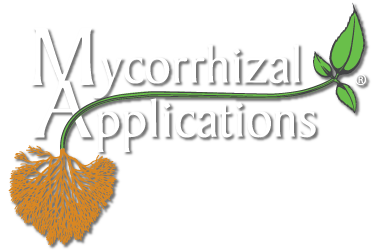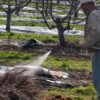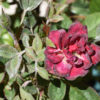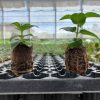From all my years in the industry, I have come to learn and appreciate that grower/retailers are the heart and soul of the horticultural industry. They participate in every step of the supply chain – from plugs to completing the sale to the home gardener. I figured it made sense to devote an entire article to the return on investment of using mycorrhizae in a grower/retailer operation.
How Mycorrhizal Fungi Work
Mycorrhizae’s main function is to expand the plant’s root mass. Plants do not become more “root-bound” with the use of mycorrhizal fungi. The expansion of the root mass is due to the development of a hyphal network that extends beyond the current root’s area of influence. Over time, the mycorrhizae impacted root mass can expand up to 50 times the original root mass. Plants treated with mycorrhizal fungi can more fully capture the nutrients and water within the root zone and/or growing container.
The increased absorptive area is difficult for us to image unless we view a 3-D microscopic root image. You cannot always see the difference when you “pop” a plant out of a pot. What you do typically see is a more mature root system with a mycorrhizal-treated plant. The mycorrhizal hyphae are better than roots at absorption. Nutrients and water can be absorbed along the entire length of the hyphae compared with just the tip for roots and root hairs.
In addition, mineral nutrients can be uptaken through hyphae from both the soluble and insoluble pools. To ensure uptake efficiency, mycorrhizal hyphae allow for more significant inflows through their system. Plants with mycorrhizal relationships develop better root absorption systems that benefit the plant.
The development of the expanded root mass helps plants to be more efficient at the uptake of nutrients and water. Mycorrhizal fungi can store nutrients and water during times of excess and make them available during times of need. Since the long-term livelihood of the mycorrhizae is linked to the long-term livelihood of the plant, the mycorrhizae will function as a nutrient and water buffer, moderating the supply of nutrients and water made available to the plant. Many nutrients become unavailable once they are applied to a growing mix. Mycorrhizae can transform those locked-up nutrients and lesser available organic nutrients into forms the plant can readily use.
Click here for a video version covering how mycorrhizae work.
How Do Growers Benefit from Mycorrhizal Fungi Use?
Mycorrhizae allows plants to better access and utilize the fertilizer you apply. Grower/Retailers get greater value for the applied nutrients when you use mycorrhizae. This concept applies whether you are feeding with a water soluble, controlled release or organic nutrients. On longer term crops, lower levels of nutrients can be used. Nitrogen and phosphorus run offs are reduced. The plant is utilizing more of what you apply.
Grower/retailers are also better able to manage their watering with mycorrhizal fungi use. The plants expanded root absorptive area absorbs more of the water applied and holds a reserve for use by the plant between waterings. Typically, we see a 36–48-hour extension before wilt steps in on gallon plant material when they are grown with mycorrhizal fungi. Mycorrhizal fungi use does not change the properties of your growing media.
Return on Investment – Improved Fertilizer Use Efficiency – Purchased Plugs and/or Rooted Cuttings
Suppose a grower/retailer is purchasing 1,000 two eighty-eight cell plug trays over a season. This same grower/retailer is using MycoApply Injector Endo Organic. Each 100-gram bag of MycoApply Injector Endo Organic produces 500 gallons of drench when used at the one gallon to one-hundred-gallon dilution rate. A grower can adjust the amount of material and drench to match the number of trays you receive each week. Each one hundred gallons drenches 330-335 plug trays. The product could be applied either as a drench or a plug dip. Take a look at some specific crop examples below.
Crop 1: Seed Begonia Plug in 4-inch pot
- Cost per treated plant is $0.003
- Crop Duration: 5-8 weeks (we will use 6.5 weeks for calculations)
- Planting: 288 cell-plug per 4-inch container
- Fertilization Rate: 200 ppm constant feed
- Average Water Application Rate: 0.04 gallons per 4-inch container per day
- Fertilizer of Choice: 20-10-20
- Application Rate: 1:100, 13.4 ounces of fertilizer per gallon of stock
- Estimate Fertilizer Cost: $60 per twenty-five-pound bag.
- Fertilizer usage per 4-inch container over the entire crop time (45.5 days x 0.04 gallons per day) 1.82 gallons per 4-inch container per 6.5-week crop time
- Cost to treat 100 gallons of fertilizer: (13.4 ounces per 1 gallon of stock per 100 gallons of final product/400 ounces per 25 lbs.) *$60 per 25 lb. bag, $2.01 per 100 gallons of fertilizer.
- Material cost to treat a 4-inch container over the entire crop (1.82 gallons/100 gallons) X $2.01 per 100 gallons: $0.0365
- Breakeven Increase Fertilizer Use Efficiency: $0.003/$0.0365 = 8.2%
Crop 2: Seed Begonia Plug in 1 gallon container
- Cost per treated plant is $0.003
- Crop Duration: 5-8 weeks (we will use 6.5 weeks for calculations)
- Planting: Two 288 cell-plug per 1 gallon container
- Fertilization Rate: 200 ppm constant feed
- Average Water Application Rate: 0.175 gallons per 1 gallon container per day
- Fertilizer of Choice: 20-10-20
- Application Rate: 1:100, 13.4 ounces of fertilizer per gallon of stock
- Estimate Fertilizer Cost: $60 per twenty-five-pound bag.
- Fertilizer usage per 1-gallon container over the entire crop time (45.5 days x 0.175 gallons per day) 7.9625 gallons per 1 gallon container per 6.5-week crop time
- Cost to treat 100 gallons of fertilizer: (13.4 ounces per 1 gallon of stock per 100 gallons of final product/400 ounces per 25 lbs.) *$60 per 25 lb. bag, $2.01 per 100 gallons of fertilizer.
- Material cost to treat a one-gallon container over the entire crop (7.9625 gallons/100 gallons) X $2.01 per 100 gallons: $0.1600
- Breakeven Increase Fertilizer Use Efficiency: $0.003/$0.1600 = 1.8%
Crop 3: Vegetative Spreading Petunia Liner in 10-inch baskets
- Cost per treated plant is $0.011
- Crop Duration: 9-11 weeks, will use 10 weeks for calculations
- Planting: 3-5 liners plants per basket, will use 4 liners for calculations
- Fertilization Rate: 200 ppm constant feed
- Average Water Application Rate: 0.35 gallons per basket per day
- Fertilizer of Choice: 20-10-20
- Application Rate: 1:100, 13.4 ounces of fertilizer per gallon of stock
- Estimate Fertilizer Cost: $60 per twenty-five-pound bag.
- Fertilizer usage per 10-inch basket over the entire crop time (70 days x 0.35 gallons per day) 24.5 gallons per 10-inch basket per 10-week crop time
- Cost to treat 100 gallons of fertilizer: (13.4 ounces per 1 gallon of stock per 100 gallons of final product/400 ounces per 25 lbs.) *$60 per 25 lb. bag, $2.01 per 100 gallons of fertilizer.
- Material cost to treat a basket over the entire crop (24.5 gallons/100 gallons) X $2.01 per 100 gallons): $0.4924
- Breakeven Increase Fertilizer Use Efficiency: $0.044/$0.4924 = 8.9%
Return on Investment – Improved Fertilizer Use Efficiency – Bareroot Roses, Fruit Trees, and Small Fruits
Suppose a grower/retailer is purchasing 100 bareroot roses in the early spring. This same grower/retailer is using MycoApply Injector Endo Organic. Each 100-gram bag of MycoApply Injector Endo Organic produces 500 gallons of drench when used at the one gallon to one-hundred-gallon dilution rate. Each one hundred gallons creates a drench volume that will treat approximately 2,400 bareroot roses. The grower would need to use 0.83 grams of MycoApply Injector Endo Organic to drench the one hundred potted roses. The product could be applied as a drench or a bareroot dip. Take a look at a crop example below.
Crop 4: Bareroot Rose in 1 gallon container
- Cost per treated plant is $0.013
- Crop Duration: 13-17 weeks, will use 15 weeks for calculations
- Planting: One bareroot plant per 1 gallon container
- Fertilization Rate: 200 ppm constant feed
- Average Water Application Rate: 0.175 gallons per 1 gallon container per day
- Fertilizer of Choice: 20-10-20
- Application Rate: 1:100, 13.4 ounces of fertilizer per gallon of stock
- Estimate Fertilizer Cost: $60 per twenty-five-pound bag.
- Fertilizer usage per one gallon container over the entire crop time (105 days x 0.175 gallons per day) 18.375 gallons per 1 gallon container per 15-week crop time
- Cost to treat 100 gallons of fertilizer: (13.4 ounces per 1 gallon of stock per 100 gallons of final product/400 ounces per 25 lbs.) *$60 per 25 lb. bag, $2.01 per 100 gallons of fertilizer.
- Material cost to treat a one-gallon container over the entire crop (18.375 gallons/100 gallons) X $2.01 per 100 gallons: $0.3693
- Breakeven Increase Fertilizer Use Efficiency: $0.013/$0.3693 = 3.5%
Fertilizer Use Efficiency Conclusion: The use of mycorrhizae can increase your fertilizer use efficiency. In dollars and cents terms, mycorrhizal fungi use can help you get more value from the fertilizer you apply since more of nutrients are absorbed and used by the plant. The breakeven point just to cover the cost of the mycorrhizae application varies by container size and crop time. In the four examples I included the breakeven threshold is as low as 1.8 % to 8.9%. All these increases in fertilizer use efficiency are achievable and reasonable for most growers. These numbers were developed for illustration purposes, your operations numbers will vary (particularly the volume of fertigation you apply).
Can you replicate these examples in your operation? A MycoApply mycorrhizae trial is the best way for you to confirm.
Return on Investment – Intangibles Unique to Grower/Retailers
The key to success for a grower/retailers is repeat sales. Most of your customers come from a defined footprint surrounding your business. The goal is always trying to get your customers to purchase more each time they are at your store and to return to your business more often. Axiom’s 2025 Gardening Outlook Survey confirmed that consumer shop at Garden Centers for the highest quality plants and to get personalized gardening support. Providing a better plant that will have greater transplant success (survivability), and long-term higher garden performance (fruits and flowers) is totally in line with why consumers shop at garden centers.
The current labor shortage is real. Both in the availability of labor, the quality of the worker and the ultimate cost of having the employee. For grower/retailers, mycorrhizae use has the potential to reduce the labor you need to grow and sell the plant, both in fertilizing labor and watering labor.
Production space is always at a premium during spring at a growing facility. The premium can be both in the availability of growing space, and the costs associated with the growing space. Crops grown with mycorrhizae typically finish sooner, allowing you to have more turns and/or retail space.
One of the areas I have seen the greatest amount of change in the green industry is the movement to vegetative cuttings becoming the primary source of plant material. This has opened the door to incredible plants that would never have been possible if we only had seed as a plant source. However, it has also increased the cost of each plant. Any product, like mycorrhizae that can reduce plant loss and increase finished salable plants, easily makes financial sense.
Transforming bareroot fruit trees, roses, small fruits and more into an offering that you can sell over a longer period and sell for more money makes sense. Adding the mycorrhizae to shorten the crop time and produce an improved product seems like an easy production option to adopt.
My hope when I began to draft this article was to help grower/retailers better understand the return on investment (ROI) of mycorrhizae use. It is clear; it makes sense for you as the grower, you as the retailer and finally for your customer.
If you have any questions about anything covered in this article or MycoApply Mycorrhizae, please contact your local Mycorrhizal Applications Representative or call 866-476-7800 or email us at inquiries@mycorrhizae.com.
Written by Blair Busenbark, Key Accounts Manager, Mycorrhizal Applications







